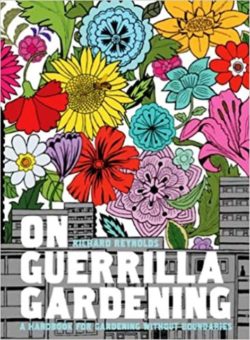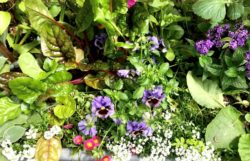Read Time: 6 Minutes Subscribe & Share
Guerilla Gardening Roots
 I spent over fifteen years looking out my apartment windows over the shop at barren tree wells, with cigarette butts and the occasional used condom embedded in the packed earth on my corner and across the street at City Hall. (This photo is an unretouched current tree well in front of City Hall). Finally, it dawned on me that if I planted something in a few tree wells, the block would look nicer. A like-minded gallery owner organized a meeting with store owners on our block to try to create public and private plantings to give an attractive and cohesive look. The various store owners squabbled incessantly, and when we located the people in charge of maintaining tree wells, we were told that planting would disturb the trees and was not allowed. Being short on perseverance, I went back to just picking up the trash around the two tree wells nearest me. And then, one day, having read about the guerrilla gardening movement in Washington, DC and New York – and with the help of a professional gardener – I screwed up my courage and planted around the closest two tree wells. Later, another professional gardener working with me said, “What about horse troughs out in front of the bay windows on the sidewalk?” Our very own guerrilla gardening movement (a small, slippery slope) took root. As Lemuel K. Washburn said, “It is necessary to distinguish between the virtue and vice of obedience.”
I spent over fifteen years looking out my apartment windows over the shop at barren tree wells, with cigarette butts and the occasional used condom embedded in the packed earth on my corner and across the street at City Hall. (This photo is an unretouched current tree well in front of City Hall). Finally, it dawned on me that if I planted something in a few tree wells, the block would look nicer. A like-minded gallery owner organized a meeting with store owners on our block to try to create public and private plantings to give an attractive and cohesive look. The various store owners squabbled incessantly, and when we located the people in charge of maintaining tree wells, we were told that planting would disturb the trees and was not allowed. Being short on perseverance, I went back to just picking up the trash around the two tree wells nearest me. And then, one day, having read about the guerrilla gardening movement in Washington, DC and New York – and with the help of a professional gardener – I screwed up my courage and planted around the closest two tree wells. Later, another professional gardener working with me said, “What about horse troughs out in front of the bay windows on the sidewalk?” Our very own guerrilla gardening movement (a small, slippery slope) took root. As Lemuel K. Washburn said, “It is necessary to distinguish between the virtue and vice of obedience.”
Green Guerrillas In Our History
 Every American child used to be taught the story of Johnny Appleseed, who flung apple seeds throughout the American Mid-West, Northeast and perhaps even into Canada. He was actually a religious (Swedeborgian) eccentric with a tin pot on his head, which served as both a hat and his cooking vessel. But he really planted nurseries, which were left in the care of neighboring farmers. He was vegetarian and had a reverence for all God’s creatures, including mosquitoes.
Every American child used to be taught the story of Johnny Appleseed, who flung apple seeds throughout the American Mid-West, Northeast and perhaps even into Canada. He was actually a religious (Swedeborgian) eccentric with a tin pot on his head, which served as both a hat and his cooking vessel. But he really planted nurseries, which were left in the care of neighboring farmers. He was vegetarian and had a reverence for all God’s creatures, including mosquitoes.
Our current history of guerrilla gardening most likely began in the early 1970s in New York, when an artist, Liz Christy, with a group of like-minded volunteers created a garden in an abandoned lot in the Bowery. You can visit it today and enjoy the turtle- and fish-filled pond, its wildflower habitat, grape arbor, groves of fruit trees, and vegetable gardens and a huge number of flowering perennials all maintained by the garden members. And now, aspiring guerrillas can get encouragement from YouTube and internet classes about gardening on the wild side. My daughters gave me a year’s membership in MasterClass, and I have enjoyed the somewhat profane and very engaging Ron Finley, who even made a film produced by John Legend about Gangsta Gardening in South Los Angeles. You should stream Can You Dig This . You may find the editing a bit erratic and the stories of the gardeners difficult to understand, but you will grow.
Across The Pond
 In the UK, it had its roots in a community of “Diggers” in the 17th century, based on the writings of Gerrard Winstanley who
In the UK, it had its roots in a community of “Diggers” in the 17th century, based on the writings of Gerrard Winstanley who  advocated community planting and rights to common land. Currently in the UK, it is Richard Reynolds who has become a highly visible Guerrilla Gardener. I remember looking at his guerrilla gardens when I came out of the Elephant And Castle tube stop. They were astonishing. Reynolds has also written a book on how you can create such wonders in your own neighborhood. He teamed up with a provocative and pro-active designer, Vanessa Harden, to create some really humorous gadgets to enliven your guerrilla gardening. She could have inspired designers for the old Get Smart TV series: Her ingenious camera shoots out seed bombs, while a shoe drops seeds onto dirt. All guerrilla gardening gurus advocate growing some edible plants along with ornamental ones. In my current efforts, my successes have been some herbs, frisée, chard, and yes, a fig tree
advocated community planting and rights to common land. Currently in the UK, it is Richard Reynolds who has become a highly visible Guerrilla Gardener. I remember looking at his guerrilla gardens when I came out of the Elephant And Castle tube stop. They were astonishing. Reynolds has also written a book on how you can create such wonders in your own neighborhood. He teamed up with a provocative and pro-active designer, Vanessa Harden, to create some really humorous gadgets to enliven your guerrilla gardening. She could have inspired designers for the old Get Smart TV series: Her ingenious camera shoots out seed bombs, while a shoe drops seeds onto dirt. All guerrilla gardening gurus advocate growing some edible plants along with ornamental ones. In my current efforts, my successes have been some herbs, frisée, chard, and yes, a fig tree
Back To Earth
In my area, I have sought advice from some professional gardeners such as Jody McGowan and Kathryn Kellam from the Master Gardeners Of Northern Virginia. Here is some very good counsel if you want to make an impact on a barren spot in your community. Get your soil tested! Soil tests can save you a lot of heartache, particularly if you have challenging pH issues, which would not be surprising in a tree box. MGNV has two places where you can pick up a testing kit, and the addresses are listed below. Knowing the pH and nutrient values is really important to making good plant choices and then adding appropriate amendments, if needed. Instructions for collecting a good sample are included in the kit. You mail the soil sample box(es) to the Virginia Tech address provided, and it takes about 2 weeks to get your results by email. The cost is $10 per sample, which you send in with the samples.
 Pinterest. If you are in the DMV, here are two local places with great reputations for sensible plants for our area. You can shop or even set up a delivery or pickup from Earth Sangha Their Wild Plant Nursery propagates and sells only local eco-types of native plants. They have contact-free delivery of their plants for members, and you can join online, check out their plant list, and pay with your credit card after the plants are delivered. You can also send pictures of your space and get their ideas on plants that would work well there.
Pinterest. If you are in the DMV, here are two local places with great reputations for sensible plants for our area. You can shop or even set up a delivery or pickup from Earth Sangha Their Wild Plant Nursery propagates and sells only local eco-types of native plants. They have contact-free delivery of their plants for members, and you can join online, check out their plant list, and pay with your credit card after the plants are delivered. You can also send pictures of your space and get their ideas on plants that would work well there.

Kitchen Detail shares under the radar recipes, explores the art of cooking, the stories behind food, and the tools that bring it all together, while uncovering the social, political, and environmental truths that shape our culinary world.




Comments are closed here.
Follow this link to create a Kitchen Detail account so that you can leave comments!